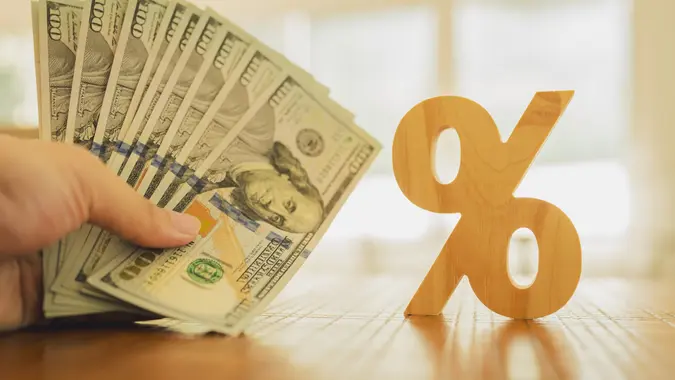I Asked ChatGPT the Fastest Way To Save an Extra $1K a Month — Here’s What It Said

Commitment to Our Readers
GOBankingRates' editorial team is committed to bringing you unbiased reviews and information. We use data-driven methodologies to evaluate financial products and services - our reviews and ratings are not influenced by advertisers. You can read more about our editorial guidelines and our products and services review methodology.

20 Years
Helping You Live Richer

Reviewed
by Experts

Trusted by
Millions of Readers
Saving an extra $1,000 a month would change your life. Just think of how fast you could build up your emergency fund, pay down debt and invest in the market if you had that $1,000 on hand. Unfortunately, those thoughts may seem like pipe dreams — you have no idea where you could possibly find that money. It’s not like the space under your couch cushions is that loaded.
You’re not alone in this dilemma. As a finance writer who’s also always looking for ways to save more money — professionally and, let’s be honest, personally — I wanted quick answers to the question of how I could save $1,000 in a month. Ideally, I’d work with a financial adviser who’s aware of my specific situation, but for the sake of expediency, I was curious what ChatGPT might say.
To keep things broad, I asked my friend ChatGPT: “What is the fastest way I can save $1,000 a month?” Here’s what it advised.
Know Where You Stand
First, ChatGPT asked me to take inventory of my current financial standing. It suggested tracking my income and spending with an app such as Monarch Money or YNAB — or, if I prefer a traditional approach, using a spreadsheet.
From there, it advised me to list my after-tax income and organize my spending into categories. While it didn’t define those by name, I assumed I’d include categories such as food and groceries, bills, rent, entertainment, student loans and pet care — areas where I regularly spend money.
“You’ll quickly see where you can cut — many people find 10% to 20% of their spending goes toward things they don’t even value,” ChatGPT said.
Cut Big, Not Small
As a millennial, I’ve been lectured about spending money on lattes a lot (like, a lot). I expected ChatGPT to deliver a similar talking-to. Instead, it refreshingly encouraged me to skip the standard advice about tiny cuts and go after the larger drains on my budget.
“Skip the ‘no lattes’ approach,” ChatGPT said. “Target the high-impact categories.”
It listed a few examples, along with potential monthly savings:
- Housing (move, downsize, find a roommate, refinance): $300-$600
- Transportation (sell a car, rideshare, change insurance): $200-$400
- Food (cook at home, meal prep, limit dining out): $200-$300
- Subscriptions and bills (cancel or negotiate): $50-$150
ChatGPT said even two of these changes could free up $1,000.
Boost Income
Since there’s only so much you can squeeze from a budget, ChatGPT also suggested finding ways to increase cash flow. Taking a side gig — such as deliveries, freelance work, tutoring or becoming a virtual assistant — could net $200 to $1,000 a month, depending on your hours and skill set.
That’s not the only option. Selling extra items around the house on Facebook Marketplace, eBay or OfferUp could bring in a few hundred dollars quickly.
Of course, you can only sell things once. For a sustainable boost in income, ChatGPT encouraged me to ask for a raise or take on overtime.
“Even $250 extra per paycheck adds up quickly,” it said.
Automate Savings
Though I’d like to think I’m diligent about saving, the truth is that sometimes I forget. I suspect many others do too. That’s why ChatGPT suggested creating a separate savings account — preferably a high-yield savings account — and setting up automatic transfers from my checking account on payday.
While ChatGPT recommended transferring $500 to $1,000 per paycheck, that amount might not be realistic for everyone. The key is to choose an amount you can save comfortably without sacrificing your ability to pay bills or cover basic necessities.
Regardless of the amount, automatically transferring money to savings forces you to live on what’s left. That can encourage thriftiness and better long-term habits.
Optimize Your Plan
Your first attempts at saving $1,000 a month don’t have to be perfect — think of them as experiments to learn what works best. ChatGPT recommends reviewing your approach after a month or two to see what’s working and what isn’t.
“Keep cutting expenses or adding income streams until $1,000 a month feels easy,” it said. “Once you hit your target, invest or earmark savings for goals such as an emergency fund or debt payoff.”
Weighing In With a Human Expert
While I appreciated the advice from ChatGPT — and plan to implement some of it (after all, it’s letting me keep my lattes) — I also wanted to check in with a budgeting expert. I turned to Andrea Woroch, a nationally recognized consumer finance expert, writer and on-air contributor, who offered two powerful tips.
Use Cash-Back Tools To Earn Money on Daily Essentials
Woroch is a big fan of finding deals and using coupons to cut costs on essentials. She also recommends using cash-back tools — such as apps and browser extensions — to earn money on purchases.
“For example, download the ShopBack web extension or app to earn cash back for just about any purchase you make online or from your phone, including retail, groceries, pet supplies and travel bookings,” she said. “This cash back adds up fast and can give your budget a little boost.”
Determine Your Spending Triggers
You’re scrolling on your phone when an ad from your favorite shop pops up. You figure there’s no harm in checking out their sale, right? Or maybe you’ve had a bad day — but nothing a little retail therapy can’t fix. You’ll feel better in the moment, but once the bill comes in, your bad day just got worse.
That’s why Woroch wants you to identify the triggers — such as the word “sale” or certain moods — that lead you to spend. Once you know what they are, she offers simple ways to overcome them — even if it means outsmarting yourself.
“For those who buy items they don’t need to feel better after a bad day, find other ways to deal with your emotions rather than indulging in retail therapy,” she said. “Finally, delete payment information stored in online retailer accounts and on social media so you can’t make an impulse purchase in the moment. This will force you to think through the purchase.”
The Bottom Line
Using ChatGPT gave me some incredibly useful tips to jump-start my savings journey. But by adding the human touch from a budgeting expert, I got the fullest picture possible. Between the two, I’m empowered to save more every month — and maybe even hit that $1,000 goal faster than I thought.
 Written by
Written by  Edited by
Edited by 

























